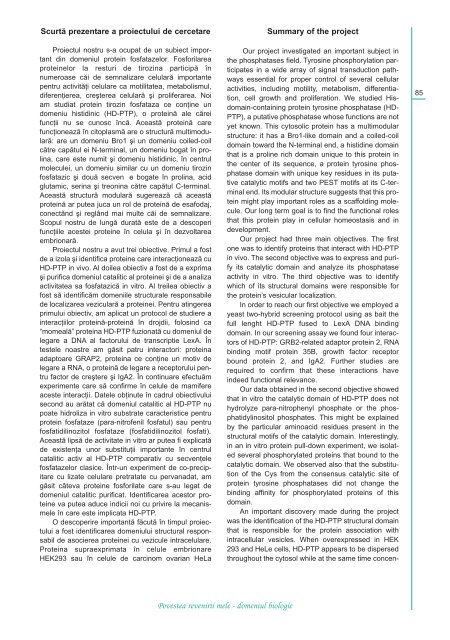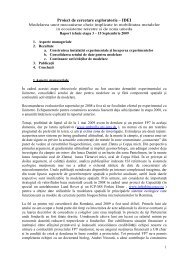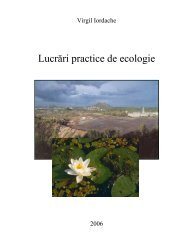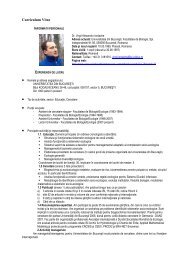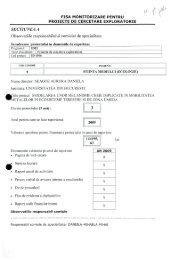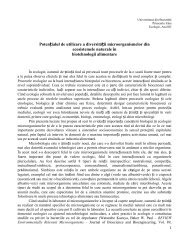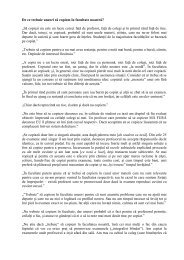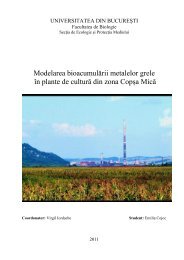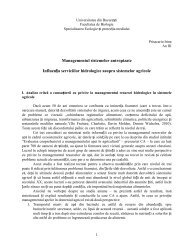Povestea revenirii mele - uefiscdi
Povestea revenirii mele - uefiscdi
Povestea revenirii mele - uefiscdi
Create successful ePaper yourself
Turn your PDF publications into a flip-book with our unique Google optimized e-Paper software.
Scurtă prezentare a proiectului de cercetare<br />
Proiectul nostru s-a ocupat de un subiect important<br />
din domeniul protein fosfatazelor. Fosforilarea<br />
proteinelor la resturi de tirozina participă în<br />
numeroase căi de semnalizare celulară importante<br />
pentru activităţi celulare ca motilitatea, metabolismul,<br />
diferenţierea, creşterea celulară şi proliferarea. Noi<br />
am studiat protein tirozin fosfataza ce conţine un<br />
domeniu histidinic (HD-PTP), o proteină ale cărei<br />
funcţii nu se cunosc încă. Această proteină care<br />
funcţionează în citoplasmă are o structură multimodulară:<br />
are un domeniu Bro1 şi un domeniu coiled-coil<br />
către capătul ei N-terminal, un domeniu bogat în prolina,<br />
care este numit şi domeniu histidinic, în centrul<br />
moleculei, un domeniu similar cu un domeniu tirozin<br />
fosfatazic şi două secven e bogate în prolina, acid<br />
glutamic, serina şi treonina către capătul C-terminal.<br />
Această structură modulară sugerează că această<br />
proteină ar putea juca un rol de proteină de esafodaj,<br />
conectând şi reglând mai multe căi de semnalizare.<br />
Scopul nostru de lungă durată este de a descoperi<br />
funcţiile acestei proteine în celula şi în dezvoltarea<br />
embrionară.<br />
Proiectul nostru a avut trei obiective. Primul a fost<br />
de a izola şi identifica proteine care interacţionează cu<br />
HD-PTP in vivo. Al doilea obiectiv a fost de a exprima<br />
şi purifica domeniul catalitic al proteinei şi de a analiza<br />
activitatea sa fosfatazică in vitro. Al treilea obiectiv a<br />
fost să identificăm domeniile structurale responsabile<br />
de localizarea veziculară a proteinei. Pentru atingerea<br />
primului obiectiv, am aplicat un protocol de studiere a<br />
interacţiilor proteină-proteină în drojdii, folosind ca<br />
“momeală” proteina HD-PTP fuzionată cu domeniul de<br />
legare a DNA al factorului de transcriptie LexA. În<br />
testele noastre am găsit patru interactori: proteina<br />
adaptoare GRAP2, proteina ce conţine un motiv de<br />
legare a RNA, o proteină de legare a receptorului pentru<br />
factor de creştere şi IgA2. În continuare efectuăm<br />
experimente care să confirme în celule de mamifere<br />
aceste interacţii. Datele obţinute în cadrul obiectivului<br />
second au arătat că domeniul catalitic al HD-PTP nu<br />
poate hidroliza in vitro substrate caracteristice pentru<br />
protein fosfataze (para-nitrofenil fosfatul) sau pentru<br />
fosfatidilinozitol fosfataze (fosfatidilinozitol fosfati).<br />
Această lipsă de activitate in vitro ar putea fi explicată<br />
de existenţa unor substituţii importante în centrul<br />
catalitic activ al HD-PTP comparativ cu secvenţele<br />
fosfatazelor clasice. Într-un experiment de co-precipitare<br />
cu lizate celulare pretratate cu pervanadat, am<br />
găsit câteva proteine fosforilate care s-au legat de<br />
domeniul catalitic purificat. Identificarea acestor proteine<br />
va putea aduce indicii noi cu privire la mecanis<strong>mele</strong><br />
în care este implicata HD-PTP.<br />
O descoperire importantă făcută în timpul proiectului<br />
a fost identificarea domeniului structural responsabil<br />
de asocierea proteinei cu vezicule intracelulare.<br />
Proteina supraexprimata în celule embrionare<br />
HEK293 sau în celule de carcinom ovarian HeLa<br />
Summary of the project<br />
Our project investigated an important subject in<br />
the phosphatases field. Tyrosine phosphorylation participates<br />
in a wide array of signal transduction pathways<br />
essential for proper control of several cellular<br />
activities, including motility, metabolism, differentiation,<br />
cell growth and proliferation. We studied Hisdomain-containing<br />
protein tyrosine phosphatase (HD-<br />
PTP), a putative phosphatase whose functions are not<br />
yet known. This cytosolic protein has a multimodular<br />
structure: it has a Bro1-like domain and a coiled-coil<br />
domain toward the N-terminal end, a histidine domain<br />
that is a proline rich domain unique to this protein in<br />
the center of its sequence, a protein tyrosine phosphatase<br />
domain with unique key residues in its putative<br />
catalytic motifs and two PEST motifs at its C-terminal<br />
end. Its modular structure suggests that this protein<br />
might play important roles as a scaffolding molecule.<br />
Our long term goal is to find the functional roles<br />
that this protein play in cellular homeostasis and in<br />
development.<br />
Our project had three main objectives. The first<br />
one was to identify proteins that interact with HD-PTP<br />
in vivo. The second objective was to express and purify<br />
its catalytic domain and analyze its phosphatase<br />
activity in vitro. The third objective was to identify<br />
which of its structural domains were responsible for<br />
the protein’s vesicular localization.<br />
In order to reach our first objective we employed a<br />
yeast two-hybrid screening protocol using as bait the<br />
full lenght HD-PTP fused to LexA DNA binding<br />
domain. In our screening assay we found four interactors<br />
of HD-PTP: GRB2-related adaptor protein 2, RNA<br />
binding motif protein 35B, growth factor receptor<br />
bound protein 2, and IgA2. Further studies are<br />
required to confirm that these interactions have<br />
indeed functional relevance.<br />
Our data obtained in the second objective showed<br />
that in vitro the catalytic domain of HD-PTP does not<br />
hydrolyze para-nitrophenyl phosphate or the phosphatidylinositol<br />
phosphates. This might be explained<br />
by the particular aminoacid residues present in the<br />
structural motifs of the catalytic domain. Interestingly,<br />
in an in vitro protein pull-down experiment, we isolated<br />
several phosphorylated proteins that bound to the<br />
catalytic domain. We observed also that the substitution<br />
of the Cys from the consensus catalytic site of<br />
protein tyrosine phosphatases did not change the<br />
binding affinity for phosphorylated proteins of this<br />
domain.<br />
An important discovery made during the project<br />
was the identification of the HD-PTP structural domain<br />
that is responsible for the protein association with<br />
intracellular vesicles. When overexpressed in HEK<br />
293 and HeLe cells, HD-PTP appears to be dispersed<br />
throughout the cytosol while at the same time concen-<br />
85<br />
<strong>Povestea</strong> <strong>revenirii</strong> <strong>mele</strong> - domeniul biologie


